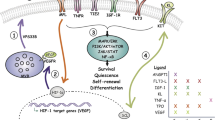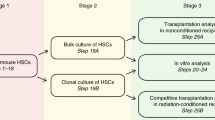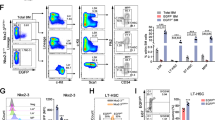Abstract
Hematopoietic stem cell (HSC) self renewal and lineage commitment depend on complex interactions with the microenvironment. The ability to maintain or expand HSCs for clinical applications or basic research has been substantially limited because these interactions are not well defined. Recent evidence suggests that HSCs reside in a low-perfusion, reduced-nutrient niche and that nutrient-sensing pathways contribute to HSC homeostasis. Here we report that suppression of the mTOR pathway, an established nutrient sensor, combined with activation of canonical Wnt–β-catenin signaling, allows for the ex vivo maintenance of human and mouse long-term HSCs under cytokine-free conditions. We also show that the combination of two clinically approved medications that together activate Wnt–β-catenin and inhibit mTOR signaling increases the number (but not the proportion) of long-term HSCs in vivo.
This is a preview of subscription content, access via your institution
Access options
Subscribe to this journal
Receive 12 print issues and online access
$209.00 per year
only $17.42 per issue
Buy this article
- Purchase on Springer Link
- Instant access to full article PDF
Prices may be subject to local taxes which are calculated during checkout





Similar content being viewed by others
References
Weissman, I.L. Stem cells: units of development, units of regeneration, and units in evolution. Cell 100, 157–168 (2000).
Purton, L.E. & Scadden, D.T. Limiting factors in murine hematopoietic stem cell assays. Cell Stem Cell 1, 263–270 (2007).
Orkin, S.H. & Zon, L.I. Hematopoiesis: an evolving paradigm for stem cell biology. Cell 132, 631–644 (2008).
Chou, S., Chu, P., Hwang, W. & Lodish, H. Expansion of human cord blood hematopoietic stem cells for transplantation. Cell Stem Cell 7, 427–428 (2010).
Lymperi, S., Ferraro, F. & Scadden, D.T. The HSC niche concept has turned 31. Has our knowledge matured? Ann. NY Acad. Sci. 1192, 12–18 (2010).
Bowman, T.V. & Zon, L.I. Lessons from the niche for generation and expansion of hematopoietic stem cells. Drug Discov. Today Ther. Strateg. 6, 135–140 (2009).
Parmar, K., Mauch, P., Vergilio, J.A., Sackstein, R. & Down, J.D. Distribution of hematopoietic stem cells in the bone marrow according to regional hypoxia. Proc. Natl. Acad. Sci. USA 104, 5431–5436 (2007).
Simsek, T. et al. The distinct metabolic profile of hematopoietic stem cells reflects their location in a hypoxic niche. Cell Stem Cell 7, 380–390 (2010).
Miharada, K. et al. Cripto regulates hematopoietic stem cells as a hypoxic-niche–related factor through cell surface receptor GRP78. Cell Stem Cell 9, 330–344 (2011).
Takubo, K. et al. Regulation of the HIF-1α level is essential for hematopoietic stem cells. Cell Stem Cell 7, 391–402 (2010).
Krock, B., Skuli, N. & Simon, M.C. The tumor suppressor LKB1 emerges as a critical factor in hematopoietic stem cell biology. Cell Metab. 13, 8–10 (2011).
Gan, B. et al. Lkb1 regulates quiescence and metabolic homeostasis of haematopoietic stem cells. Nature 468, 701–704 (2010).
Gurumurthy, S. et al. The Lkb1 metabolic sensor maintains haematopoietic stem cell survival. Nature 468, 659–663 (2010).
Nakada, D., Saunders, T.L. & Morrison, S.J. Lkb1 regulates cell cycle and energy metabolism in haematopoietic stem cells. Nature 468, 653–658 (2010).
Yilmaz, O.H. et al. Pten dependence distinguishes haematopoietic stem cells from leukaemia-initiating cells. Nature 441, 475–482 (2006).
Zhang, J. et al. PTEN maintains haematopoietic stem cells and acts in lineage choice and leukaemia prevention. Nature 441, 518–522 (2006).
Chen, C. et al. TSC-mTOR maintains quiescence and function of hematopoietic stem cells by repressing mitochondrial biogenesis and reactive oxygen species. J. Exp. Med. 205, 2397–2408 (2008).
Hofmeister, C.C., Zhang, J., Knight, K.L., Le, P. & Stiff, P.J. Ex vivo expansion of umbilical cord blood stem cells for transplantation: growing knowledge from the hematopoietic niche. Bone Marrow Transplant. 39, 11–23 (2007).
Zhang, C.C., Kaba, M., Iizuka, S., Huynh, H. & Lodish, H.F. Angiopoietin-like 5 and IGFBP2 stimulate ex vivo expansion of human cord blood hematopoietic stem cells as assayed by NOD/SCID transplantation. Blood 111, 3415–3423 (2008).
Zhang, C.C. et al. Angiopoietin-like proteins stimulate ex vivo expansion of hematopoietic stem cells. Nat. Med. 12, 240–245 (2006).
Himburg, H.A. et al. Pleiotrophin regulates the expansion and regeneration of hematopoietic stem cells. Nat. Med. 16, 475–482 (2010).
Delaney, C. et al. Notch-mediated expansion of human cord blood progenitor cells capable of rapid myeloid reconstitution. Nat. Med. 16, 232–236 (2010).
Goessling, W. et al. Genetic interaction of PGE2 and Wnt signaling regulates developmental specification of stem cells and regeneration. Cell 136, 1136–1147 (2009).
Boitano, A.E. et al. Aryl hydrocarbon receptor antagonists promote the expansion of human hematopoietic stem cells. Science 329, 1345–1348 (2010).
Perry, J.M. et al. Cooperation between both Wnt/β-catenin and PTEN/PI3K/Akt signaling promotes primitive hematopoietic stem cell self-renewal and expansion. Genes Dev. 25, 1928–1942 (2011).
Zhang, C.C. & Lodish, H.F. Murine hematopoietic stem cells change their surface phenotype during ex vivo expansion. Blood 105, 4314–4320 (2005).
Staal, F.J., Burgering, B.M., van de Wetering, M. & Clevers, H.C. Tcf-1–mediated transcription in T lymphocytes: differential role for glycogen synthase kinase-3 in fibroblasts and T cells. Int. Immunol. 11, 317–323 (1999).
Reya, T. & Clevers, H. Wnt signalling in stem cells and cancer. Nature 434, 843–850 (2005).
Staal, F.J. & Sen, J.M. The canonical Wnt signaling pathway plays an important role in lymphopoiesis and hematopoiesis. Eur. J. Immunol. 38, 1788–1794 (2008).
Malhotra, S. & Kincade, P.W. Wnt-related molecules and signaling pathway equilibrium in hematopoiesis. Cell Stem Cell 4, 27–36 (2009).
Sato, N., Meijer, L., Skaltsounis, L., Greengard, P. & Brivanlou, A.H. Maintenance of pluripotency in human and mouse embryonic stem cells through activation of Wnt signaling by a pharmacological GSK-3–specific inhibitor. Nat. Med. 10, 55–63 (2004).
Trowbridge, J.J., Xenocostas, A., Moon, R.T. & Bhatia, M. Glycogen synthase kinase-3 is an in vivo regulator of hematopoietic stem cell repopulation. Nat. Med. 12, 89–98 (2006).
Luis, T.C. et al. Canonical wnt signaling regulates hematopoiesis in a dosage-dependent fashion. Cell Stem Cell 9, 345–356 (2011).
Luis, T.C. et al. Wnt3a deficiency irreversibly impairs hematopoietic stem cell self-renewal and leads to defects in progenitor cell differentiation. Blood 113, 546–554 (2009).
Zhao, C. et al. Loss of β-catenin impairs the renewal of normal and CML stem cells in vivo. Cancer Cell 12, 528–541 (2007).
Fleming, H.E. et al. Wnt signaling in the niche enforces hematopoietic stem cell quiescence and is necessary to preserve self-renewal in vivo. Cell Stem Cell 2, 274–283 (2008).
Willert, K. et al. Wnt proteins are lipid-modified and can act as stem cell growth factors. Nature 423, 448–452 (2003).
Reya, T. et al. A role for Wnt signalling in self-renewal of haematopoietic stem cells. Nature 423, 409–414 (2003).
Cobas, M. β-catenin is dispensable for hematopoiesis and lymphopoiesis. J. Exp. Med. 199, 221–229 (2004).
Jeannet, G. et al. Long-term, multilineage hematopoiesis occurs in the combined absence of β-catenin and γ-catenin. Blood 111, 142–149 (2008).
Koch, U. et al. Simultaneous loss of β- and γ-catenin does not perturb hematopoiesis or lymphopoiesis. Blood 111, 160–164 (2008).
Kirstetter, P., Anderson, K., Porse, B.T., Jacobsen, S.E. & Nerlov, C. Activation of the canonical Wnt pathway leads to loss of hematopoietic stem cell repopulation and multilineage differentiation block. Nat. Immunol. 7, 1048–1056 (2006).
Scheller, M. et al. Hematopoietic stem cell and multilineage defects generated by constitutive β-catenin activation. Nat. Immunol. 7, 1037–1047 (2006).
Huang, J. et al. Pivotal role for Gsk3 in hematopoietic stem cell homeostasis in mice. J. Clin. Invest. 119, 3519–3529 (2009).
Inoki, K. et al. TSC2 integrates Wnt and energy signals via a coordinated phosphorylation by AMPK and GSK3 to regulate cell growth. Cell 126, 955–968 (2006).
Holmes, R. & Zúñiga-Pflücker, J.C. The OP9–DL1 system: generation of T-lymphocytes from embryonic or hematopoietic stem cells in vitro. Cold Spring Harb. Protoc. published online, doi:10.1101/pdb.prot5156 (February 2009).
Kodama, H., Nose, M., Niida, S., Nishikawa, S. & Nishikawa, S. Involvement of the c-Kit receptor in the adhesion of hematopoietic stem cells to stromal cells. Exp. Hematol. 22, 979–984 (1994).
Zediak, V.P., Maillard, I. & Bhandoola, A. Multiple prethymic defects underlie age-related loss of T progenitor competence. Blood 110, 1161–1167 (2007).
Richie Ehrlich, L.I., Serwold, T. & Weissman, I.L. In vitro assays misrepresent in vivo lineage potentials of murine lymphoid progenitors. Blood 117, 2618–2624 (2011).
Maretto, S. et al. Mapping Wnt/β-catenin signaling during mouse development and in colorectal tumors. Proc. Natl. Acad. Sci. USA 100, 3299–3304 (2003).
Castilho, R.M., Squarize, C.H., Chodosh, L.A., Williams, B.O. & Gutkind, J.S. mTOR mediates Wnt-induced epidermal stem cell exhaustion and aging. Cell Stem Cell 5, 279–289 (2009).
Boggs, D.R. & Joyce, R.A. The hematopoietic effects of lithium. Semin. Hematol. 20, 129–138 (1983).
Ballin, A., Lehman, D., Sirota, P., Litvinjuk, U. & Meytes, D. Increased number of peripheral blood CD34+ cells in lithium-treated patients. Br. J. Haematol. 100, 219–221 (1998).
Holmes, T. et al. Glycogen synthase kinase-3β inhibition preserves hematopoietic stem cell activity and inhibits leukemic cell growth. Stem Cells 26, 1288–1297 (2008).
Polakis, P. Wnt signaling and cancer. Genes Dev. 14, 1837–1851 (2000).
Wang, Y. et al. The Wnt/β-catenin pathway is required for the development of leukemia stem cells in AML. Science 327, 1650–1653 (2010).
Cohen, Y., Chetrit, A., Sirota, P. & Modan, B. Cancer morbidity in psychiatric patients: influence of lithium carbonate treatment. Med. Oncol. 15, 32–36 (1998).
Gattinoni, L. et al. A human memory T cell subset with stem cell–like properties. Nat. Med. 17, 1290–1297 (2011).
Gattinoni, L., Klebanoff, C.A. & Restifo, N.P. Pharmacologic induction of CD8+ T cell memory: better living through chemistry. Sci. Transl. Med. 1, 11ps12 (2009).
Schmitt, T.M. & Zuniga-Pflucker, J.C. Induction of T cell development from hematopoietic progenitor cells by delta-like-1 in vitro. Immunity 17, 749–756 (2002).
Acknowledgements
We thank W. Tong, N. Speck, A. Bhandoola, A. Chi and H.-C. Huang for insightful comments and discussion. We also thank A. Bhandoola (University of Pennsylvania) for providing OP9 and OP9-DL1 cells. We thank J. Garskof, A. Christian and A. Mezochow for technical help and all members of the Klein lab for help and discussions. We specially thank A. Secreto and C. Keefer of the Stem Cell and Xenograft Core and Flow Cytometry and Cell Sorting Facility at the University of Pennsylvania for technical support. This study was supported by a grant from the Institute for Translational Medicine and Therapeutics (ITMAT) at the University of Pennsylvania and by grants from the US National Institutes of Health to P.S.K. (1R21HL107968-01 and 1R01HL110806-01). J.H. was supported by a Leukemia and Lymphoma Society Career Development Award and a K99 award from the US National Institutes of Health (1K99HL10774701). E.O.H. was supported by a grant from the US National Institutes of Health (1-K23-HL-093366-01A1). We also appreciate support from the Human Hematopoietic Stem Cell Center of Excellence (5P30DK090969-02) at the Children's Hospital of Philadelphia and the University of Pennsylvania.
Author information
Authors and Affiliations
Contributions
J.H. designed and performed experiments, interpreted data and wrote the manuscript. M.N.-M. performed experiments, interpreted data and contributed to the writing of the manuscript. E.O.H. contributed to the design and interpretation of experiments and the writing of the manuscript. G.D.-D. assisted with the design and interpretation of xenograft experiments. P.S.K. oversaw the design and interpretation of all experiments and the writing of the manuscript.
Corresponding author
Ethics declarations
Competing interests
The authors declare no competing financial interests.
Supplementary information
Supplementary Text and Figures
Supplementary Figures 1–5 (PDF 7111 kb)
Rights and permissions
About this article
Cite this article
Huang, J., Nguyen-McCarty, M., Hexner, E. et al. Maintenance of hematopoietic stem cells through regulation of Wnt and mTOR pathways. Nat Med 18, 1778–1785 (2012). https://doi.org/10.1038/nm.2984
Received:
Accepted:
Published:
Issue Date:
DOI: https://doi.org/10.1038/nm.2984
This article is cited by
-
Deep learning-based predictive classification of functional subpopulations of hematopoietic stem cells and multipotent progenitors
Stem Cell Research & Therapy (2024)
-
Chemically defined cytokine-free expansion of human haematopoietic stem cells
Nature (2023)
-
The mechanisms of mutual relationship between malignant hematologic cells and mesenchymal stem cells: Does it contradict the nursing role of mesenchymal stem cells?
Cell Communication and Signaling (2022)
-
Co-culture of mesenchymal stem cell spheres with hematopoietic stem cells under hypoxia: a cost-effective method to maintain self-renewal and homing marker expression
Molecular Biology Reports (2022)
-
GSK-3: a multifaceted player in acute leukemias
Leukemia (2021)



